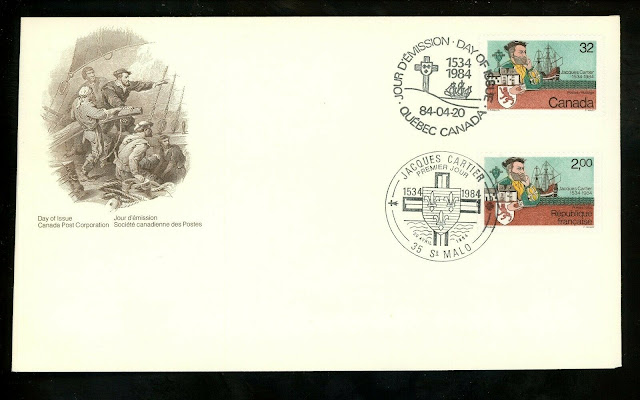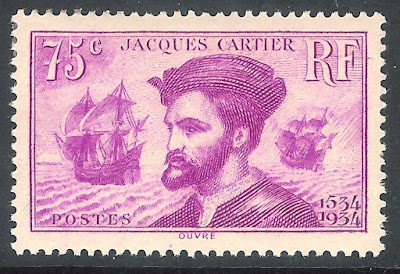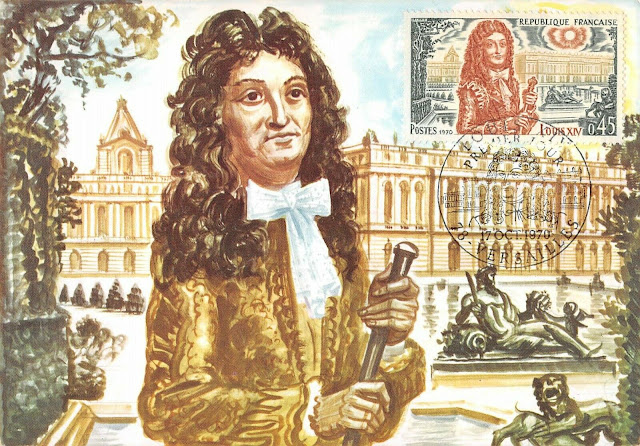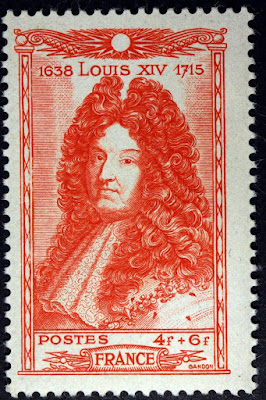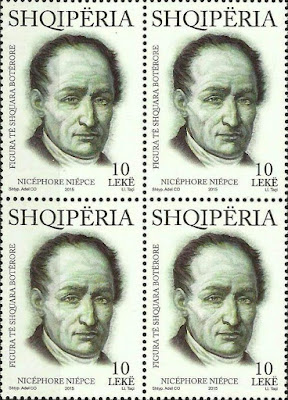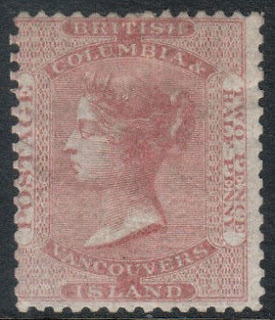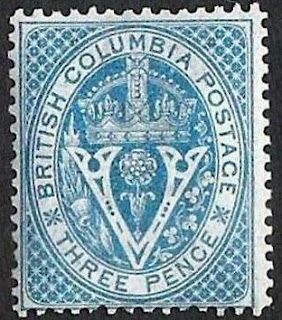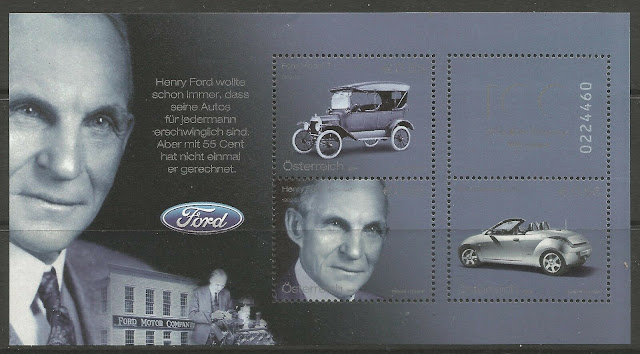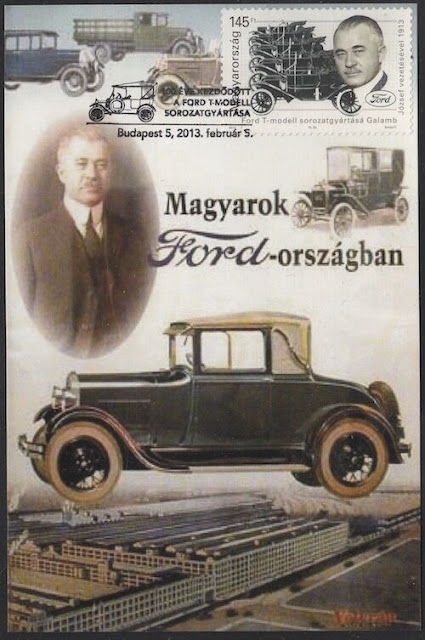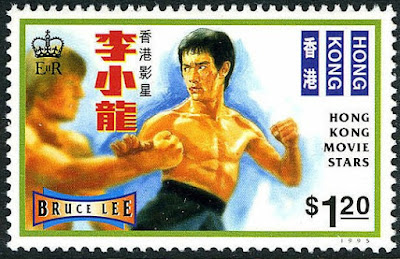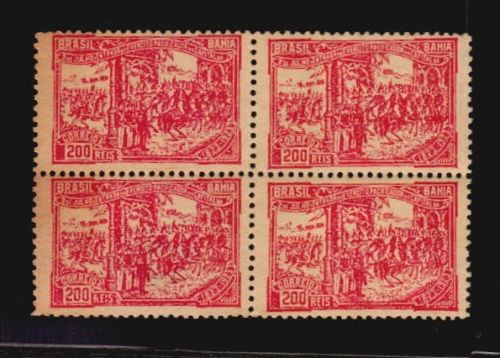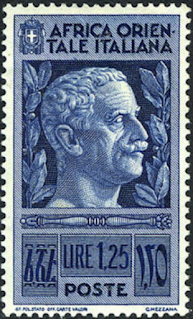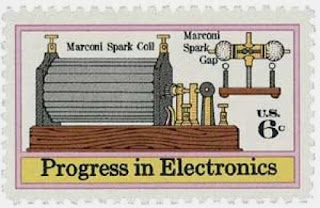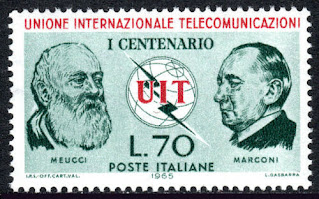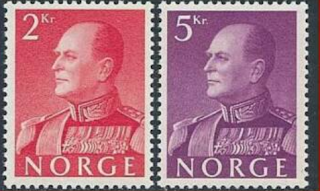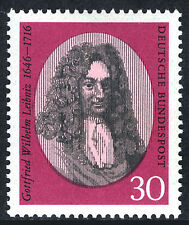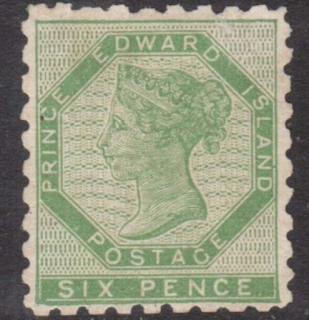Sunday, September 01, 2019
September 1st in stamps Jacques Cartier, Engelbert Humperdinck, Louis XIV
1557 Died: Jacques Cartier, French navigator and explorer (b. 1491)
Jacques Cartier (December 31, 1491 – September 1, 1557) was a Breton explorer who claimed what is now Canada for France. Jacques Cartier was the first European to describe and map the Gulf of Saint Lawrence and the shores of the Saint Lawrence River, which he named "The Country of Canadas", after the Iroquois names for the two big settlements he saw at Stadacona (Quebec City) and at Hochelaga (Montreal Island).
Some stamps and a First Day Cover from France and Canada depicting Jacques Cartier
1715 Died: Louis XIV of France (b. 1638)
Louis XIV (Louis Dieudonné; 5 September 1638 – 1 September 1715), known as Louis the Great (Louis le Grand) or the Sun King (le Roi Soleil), was King of France from 14 May 1643 until his death in 1715. His reign of 72 years and 110 days is the longest recorded of any monarch of a sovereign country in European history. In the age of absolutism in Europe, Louis XIV's France was a leader in the growing centralization of power.
Louis began his personal rule of France in 1661, after the death of his chief minister, the Italian Cardinal Mazarin. An adherent of the concept of the divine right of kings, Louis continued his predecessors' work of creating a centralized state governed from the capital. He sought to eliminate the remnants of feudalism persisting in parts of France and, by compelling many members of the nobility to inhabit his lavish Palace of Versailles, succeeded in pacifying the aristocracy, many members of which had participated in the Fronde rebellion during Louis' minority. By these means he became one of the most powerful French monarchs and consolidated a system of absolute monarchical rule in France that endured until the French Revolution.
Some France stamps and a maximum card depicting Louis XIV
1854 Born: Engelbert Humperdinck, German playwright and composer (d. 1921)
Engelbert Humperdinck (1 September 1854 – 27 September 1921) was a German composer, best known for his opera Hansel and Gretel.
Humperdinck's reputation rests chiefly on his opera Hänsel und Gretel, which he began work on in Frankfurt in 1890. He first composed four songs to accompany a puppet show his nieces were giving at home. Then, using a libretto by his sister Adelheid Wette rather loosely based on the version of the fairy tale by the Brothers Grimm, he composed a singspiel of 16 songs with piano accompaniment and connecting dialogue. By January 1891 he had begun working on a complete orchestration.
The opera premiered in Weimar on 23 December 1893, under the baton of Richard Strauss. With its highly original synthesis of Wagnerian techniques and traditional German folk songs, Hansel and Gretel was an instant and overwhelming success.
Hansel and Gretel has always been Humperdinck's most popular work. In 1923 the Royal Opera House (London) chose it for their first complete radio opera broadcast. Eight years later, it was the first opera transmitted live from the Metropolitan Opera (New York).
Below is a German First Day Cover issued for the 150th birthday anniversary of Engelbert Humperdinck
Monday, July 22, 2019
July 22nd in stamps Alexander Mackenzie, Wiley Post, Randal Cremer
1793 – Alexander Mackenzie reaches the Pacific Ocean becoming the first recorded human to complete a transcontinental crossing of North America.
Sir Alexander Mackenzie (or MacKenzie, Scottish Gaelic: Alasdair MacCoinnich; 1764 – 12 March 1820) was a Scottish explorer known for accomplishing the first east to west crossing of North America north of Mexico, which preceded the more famous Lewis and Clark Expedition by 12 years. His overland crossing of what is now Canada reached the Pacific Ocean in 1793. The Mackenzie River, the longest river system in Canada and the second longest in North America, is named after him.
Canadian stamps issued to commemorate Alexander Mackenzie
1908 Died: Randal Cremer, English activist and politician, Nobel Prize laureate (b. 1828)
Stamp issued by Guinea Bissau depicting Randal Cremer
1933 – Aviator Wiley Post returns to Floyd Bennett Field in New York City, completing the first solo flight around the world in seven days, 18 hours and 49 minutes.
Wiley Hardeman Post (November 22, 1898 – August 15, 1935) was a famed American aviator during the interwar period, the first pilot to fly solo around the world. Also known for his work in high-altitude flying, Post helped develop one of the first pressure suits and discovered the jet stream. On August 15, 1935, Post and American humorist Will Rogers were killed when Post's aircraft crashed on takeoff from a lagoon near Point Barrow in the Territory of Alaska.
Post's Lockheed Vega aircraft, the Winnie Mae, was on display at the National Air and Space Museum's Steven F. Udvar-Hazy Center from 2003 to 2011. It is now featured in the "Time and Navigation" gallery on the second floor of the National Air and Space Museum in Washington, D.C.
Stamps issued to commemorate Wiley Post
Saturday, July 20, 2019
July 20th in Stamps Niépce British Columbia joins Canada, Moon landing, Ford ships 1st car, Bruce Lee died
1656 Born: Johann Bernhard Fischer von Erlach, Austrian architect, sculptor and historian (d. 1723)
Johann Bernhard Fischer von Erlach (20 July 1656 – 5 April 1723) was an Austrian architect, sculptor, and architectural historian whose Baroque architecture profoundly influenced and shaped the tastes of the Habsburg Empire. His influential book A Plan of Civil and Historical Architecture (1721) was one of the first and most popular comparative studies of world architecture. His major works include Schönbrunn Palace, Karlskirche, and the Austrian National Library in Vienna, and Schloss Klessheim, Holy Trinity Church, and the Kollegienkirche in Salzburg.
Austrian stamp depicting Johann Bernhard Fischer von Erlach
1807 – Nicéphore Niépce is awarded a patent by Napoleon for the Pyréolophore, the world's first internal combustion
Joseph Nicéphore Niépce (7 March 1765 – 5 July 1833), commonly known or referred to simply as Nicéphore Niépce, was a French inventor, usually credited as the inventor of photography and a pioneer in that field. Niépce developed heliography, a technique he used to create the world's oldest surviving product of a photographic process: a print made from a photoengraved printing plate in 1825. In 1826 or 1827, he used a primitive camera to produce the oldest surviving photograph of a real-world scene. Among Niépce's other inventions was the Pyréolophore, the world's first internal combustion engine, which he conceived, created, and developed with his older brother Claude.
Here are some stamps from Albania and France depicting Nicéphore Niépce
1871 – British Columbia joins the confederation of Canada.
British Columbia (BC; French: Colombie-Britannique) is the westernmost province of Canada, located between the Pacific Ocean and the Rocky Mountains. With an estimated population of 5.034 million as of 2019, it is Canada's third-most populous province.
With the agreement by the Canadian government to extend the Canadian Pacific Railway to British Columbia and to assume the colony's debt, British Columbia became the sixth province to join Confederation on July 20, 1871
Some early British Columbia stamps
1973 Died: Bruce Lee, American-Chinese actor, martial artist, and screenwriter (b. 1940)
Lee Jun-fan (Chinese: 李振藩; November 27, 1940 – July 20, 1973), commonly known as Bruce Lee (Chinese: 李小龍), was a Chinese, Hong Kong American actor, director, martial artist, martial arts instructor and philosopher. He was the founder of Jeet Kune Do, a hybrid martial arts philosophy drawing from different combat disciplines that is often credited with paving the way for modern mixed martial arts (MMA). Lee is considered by commentators, critics, media, and other martial artists to be the most influential martial artist of all time and a pop culture icon of the 20th century, who bridged the gap between East and West. He is credited with helping to change the way Asians were presented in American films.
The son of Cantonese opera star Lee Hoi-chuen, Lee was born in the Chinatown area of San Francisco, California, on November 27, 1940, to parents from Hong Kong, and was raised with his family in Kowloon, Hong Kong. He was introduced to the film industry by his father and appeared in several films as a child actor. Lee moved to the United States at the age of 18 to receive his higher education at the University of Washington in Seattle, and it was during this time that he began teaching martial arts. His Hong Kong and Hollywood-produced films elevated the traditional martial arts film to a new level of popularity and acclaim, sparking a surge of interest in the Chinese nation and Chinese martial arts in the West in the 1970s. The direction and tone of his films dramatically changed and influenced martial arts and martial arts films in the world.
He is noted for his roles in five feature-length martial arts films in the early 1970s: Lo Wei's The Big Boss (1971) and Fist of Fury (1972); Golden Harvest's Way of the Dragon (1972), directed and written by Lee; Golden Harvest and Warner Brothers' Enter the Dragon (1973) and The Game of Death (1978), both directed by Robert Clouse. Lee became an iconic figure known throughout the world, particularly among the Chinese, based upon his portrayal of Chinese nationalism in his films and among Asian Americans for defying stereotypes associated with the emasculated Asian male. He trained in the art of Wing Chun and later combined his other influences from various sources into the spirit of his personal martial arts philosophy, which he dubbed Jeet Kune Do (The Way of the Intercepting Fist). Lee had residences in Hong Kong and Seattle.
Lee died on July 20, 1973 at the age of 32. There was no visible external injury; however, according to autopsy reports, Lee's brain had swollen considerably. The autopsy found Equagesic in his system. When the doctors announced Lee's death, it was officially ruled a "death by misadventure". Since his death, Lee has continued to be a prominent influence on modern combat sport, including judo, karate, mixed martial arts, and boxing. Time named Lee one of the 100 most important people of the 20th century.
Hong Kong stamp depicting Bruce Lee
Sunday, April 14, 2019
July 2nd in Stamps Bahia, Victor Emmanuel II, Marconi, Zeppelin, Olav V of Norway, Hermann Hesse, James Stewart, Jean-Jacques Rousseau
1778 Died: Jean-Jacques Rousseau, Swiss philosopher and polymath (b. 1712)
Jean-Jacques Rousseau (28 June 1712 – 2 July 1778) was a Genevan philosopher, writer, and composer. His political philosophy influenced the progress of the Enlightenment throughout Europe, as well as aspects of the French Revolution and the development of modern political, economic, and educational thought.
His Discourse on Inequality and The Social Contract are cornerstones in modern political and social thought. Rousseau's sentimental novel Julie, or the New Heloise (1761) was important to the development of preromanticism and romanticism in fiction. His Emile, or On Education (1762) is an educational treatise on the place of the individual in society. Rousseau's autobiographical writings—the posthumously published Confessions (composed in 1769), which initiated the modern autobiography, and the unfinished Reveries of the Solitary Walker (composed 1776–1778)—exemplified the late-18th-century "Age of Sensibility", and featured an increased focus on subjectivity and introspection that later characterized modern writing.
Rousseau befriended fellow philosopher Denis Diderot in 1742, and would later write about Diderot's romantic troubles in his Confessions. During the period of the French Revolution, Rousseau was the most popular of the philosophers among members of the Jacobin Club. He was interred as a national hero in the Panthéon in Paris, in 1794, 16 years after his death.
Swiss and Russian stamps depicting Jean-Jacques Rousseau
1823 – Bahia Independence Day: The end of Portuguese rule in Brazil, with the final defeat of the Portuguese crown loyalists in the province of Bahia.
The Siege of Salvador occurred during the Brazilian War of Independence, during which the Brazilian Army, under Pierre Labatut, attempted to capture the city of Salvador in Bahia from its Portuguese Army defenders. The siege lasted from 2 March 1822 until 2 July 1823, finally ending when the Portuguese commander, Inácio Luís Madeira de Melo, surrendered his forces to the Brazilians
Victor Emmanuel II (Italian: Vittorio Emanuele II; full name: Vittorio Emanuele Maria Alberto Eugenio Ferdinando Tommaso di Savoia; 14 March 1820 – 9 January 1878) was King of Sardinia from 1849 until 17 March 1861. At that point, he assumed the title of King of Italy and became the first king of a united Italy since the 6th century, a title he held until his death in 1878. The Italians gave him the epithet of Father of the Fatherland (Italian: Padre della Patria). The monument Altare della Patria (or Vittoriano) in Rome was built in his honor.
Guglielmo Marconi, 1st Marquis of Marconi (25 April 1874 – 20 July 1937) was an Italian inventor and electrical engineer, known for his pioneering work on long-distance radio transmission,[5] development of Marconi's law, and a radio telegraph system. He is credited as the inventor of radio, and he shared the 1909 Nobel Prize in Physics with Karl Ferdinand Braun "in recognition of their contributions to the development of wireless telegraphy".
Marconi was also an entrepreneur, businessman, and founder of The Wireless Telegraph & Signal Company in the United Kingdom in 1897 (which became the Marconi Company). He succeeded in making an engineering and commercial success of radio by innovating and building on the work of previous experimenters and physicists. In 1929, Marconi was ennobled as a Marchese (marquis) by King Victor Emmanuel III of Italy, and, in 1931, he set up the Vatican Radio for Pope Pius XI.
Some stamps from the US, Italy, Bahamas, Canada and Niger depicting Marconi
LZ 127 Graf Zeppelin (Deutsches Luftschiff Zeppelin #127; Registration: D-LZ 127) was a German-built and -operated, passenger-carrying, hydrogen-filled, rigid airship which operated commercially from 1928 to 1937. It was named after the German pioneer of airships, Ferdinand von Zeppelin, who was a Graf or Count in the German nobility. During its operating life, the airship made 590 flights covering more than a million miles (1.6 million km). It was designed to be operated by a crew of 36 officers and men. More about that here: http://en.wikipedia.org/wiki/LZ_127_Graf_Zeppelin
Some stamps from the US and Germany depicting Zeppelins

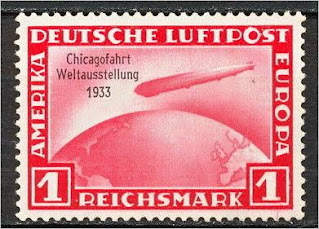




More Zeppelin stamps can be found here: Zeppelin on stamps
Olav V (born Prince Alexander of Denmark; 2 July 1903 – 17 January 1991) was King of Norway from 1957 until his death.
Olav was the only child of King Haakon VII of Norway and Maud of Wales. He became heir apparent to the Norwegian throne when his father was elected King of Norway in 1905. He was the first heir to the Norwegian throne to be brought up in Norway since Olav IV, and his parents made sure he was given as Norwegian an upbringing as possible. In preparation for his future role, he attended both civilian and military schools. In 1929, he married his first cousin Princess Märtha of Sweden. During World War II his leadership was much appreciated and he was appointed Norwegian Chief of Defence in 1944. At his death in 1991, he was the last surviving grandchild of Edward VII of the United Kingdom and Alexandra of Denmark.
Due to his considerate, down-to-earth style, King Olav was immensely popular, resulting in the nickname Folkekongen ("The People's King"). In a 2005 poll by the Norwegian Broadcasting Corporation, Olav was voted "Norwegian of the Century"
July 1st in Stamps
1646 – Born: Gottfried Wilhelm Leibniz, German mathematician and philosopher (d. 1716)
Gottfried Wilhelm (von) Leibniz (sometimes spelled Leibnitz) or French: Godefroi Guillaume Leibnitz (1 July 1646 [O.S. 21 June] – 14 November 1716) was a prominent German (of Slavic origin) polymath and philosopher in the history of mathematics and the history of philosophy. His most notable accomplishment was conceiving the ideas of differential and integral calculus, independently of Isaac Newton's contemporaneous developments. Mathematical works have always favored Leibniz's notation as the conventional expression of calculus, while Newton's notation became unused. It was only in the 20th century that Leibniz's law of continuity and transcendental law of homogeneity found mathematical implementation (by means of non-standard analysis). He became one of the most prolific inventors in the field of mechanical calculators. While working on adding automatic multiplication and division to Pascal's calculator, he was the first to describe a pinwheel calculator in 1685 and invented the Leibniz wheel, used in the arithmometer, the first mass-produced mechanical calculator. He also refined the binary number system, which is the foundation of all digital computers.
Here are some stamps from Germany and Ukraine depicting Leibniz
1867 – The British North America Act of 1867 takes effect as the Province of Canada,
New Brunswick, and Nova Scotia join into confederation to create the modern nation of Canada.
Sir John A. Macdonald is sworn in as the first Prime Minister of Canada. This date is commemorated annually in Canada as Canada Day, a national holiday.
Here are the first Canadian stamps
1873 – Prince Edward Island joins into Canadian Confederation.
The first Prince Edward Island stamps
The Universal Postal Union (UPU, French: Union postale universelle), established by the Treaty of Bern of 1874, is a specialized agency of the United Nations (UN) that coordinates postal policies among member nations, in addition to the worldwide postal system. The UPU contains four bodies consisting of the Congress, the Council of Administration (CA), the Postal Operations Council (POC) and the International Bureau (IB). It also oversees the Telematics and Express Mail Service (EMS) cooperatives. Each member agrees to the same terms for conducting international postal duties. The UPU's headquarters are located in Bern, Switzerland.
The Congo Free State also known as the Independent State of the Congo (French: État indépendant du Congo, Dutch: Kongo-Vrijstaat) was a large state in Central Africa from 1885 to 1908. It was ruled personally by Leopold II and not by the government of Belgium, of which he was the constitutional monarch. Leopold II was able to procure the region by convincing other Eurasian states at the Berlin Conference that he was involved in humanitarian and philanthropic work and would not tax trade.
Via the International Association of the Congo, he was able to lay claim to most of the Congo basin. On 29 May 1885, i.e. after the closure of the Berlin Conference, the king announced that he planned to name his possessions "the Congo Free State", an appellation which was not yet used at the Berlin Conference and which officially replaced "International Association of the Congo" on 1 August 1885. The Congo Free State operated as a corporate state privately controlled by Leopold II. The state included the entire area of the present Democratic Republic of the Congo and existed from 1885 to 1908, when the government of Belgium reluctantly annexed the area.
1903 – Start of first Tour de France bicycle race.
The 1903 Tour de France was the first cycling race set up and sponsored by the newspaper L'Auto, ancestor of the current daily, L'Équipe. It ran from 1 to 19 July in six stages over 2,428 km (1,509 mi), and was won by Maurice Garin.
Here are some stamps from France, Luxembourg and the Isle of Man showing the Tour de France
A ZIP Code is a postal code used by the United States Postal Service (USPS) in a system it introduced in 1963. The term ZIP is an acronym for Zone Improvement Plan;[1] it was chosen to suggest that the mail travels more efficiently and quickly (zipping along) when senders use the code in the postal address. The basic format consists of five digits. An extended ZIP+4 code was introduced in 1983 which includes the five digits of the ZIP Code, followed by a hyphen and four additional digits that reference a more specific location.
1990 – German reunification: East Germany accepts the Deutsche Mark as its currency, thus uniting the economies of East and West Germany.
The German reunification (German: Deutsche Wiedervereinigung) was the process in 1990 in which the German Democratic Republic (GDR, colloquially East Germany; German: Deutsche Demokratische Republik/DDR) became part of the Federal Republic of Germany (FRG, colloquially West Germany; German: Bundesrepublik Deutschland/BRD) to form the reunited nation of Germany, and when Berlin reunited into a single city, as provided by its then Grundgesetz (constitution) Article 23. The end of the unification process is officially referred to as German unity (German: Deutsche Einheit), celebrated on 3 October (German Unity Day) (German: Tag der deutschen Einheit). Following German reunification, Berlin was once again designated as the capital of united Germany.
2013 – Croatia becomes the 28th member of the European Union.
